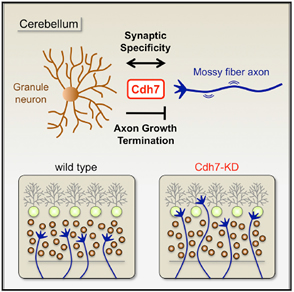Research Highlights
Vol.4, Jun 2015
A dual role for protein Cdh7 in correct cerebellum development
Precise neural connectivity and the correct formation of synapses are crucial for creating and maintaining a healthy nervous system. The cerebellum – the region of the brain responsible for motor control – relies on synaptic connections between neurons to form a fully functioning circuit.
More specifically, so-called ‘mossy fibers’ convey information to the cerebellum from other parts of the brain. In order to set up this communication network, mossy fiber pontive nucleus (PN) neurons grow and reach out via axons (or nerve fibers) to connect with cerebellar granule neurons in the developing brain. This normally occurs by the third postnatal week. However, the molecular mechanism alerting the PN neurons to stop growing and establish connections with the granule neurons has not yet been identified.
Now, Hideyuki Okano and co-workers at Keio University, in collaboration with scientists at Jikei University School of Medicine in Tokyo, Japan, have shown that a protein called cadherin-7 (Cdh7) plays a dual role in stopping axon growth of PN neurons at the right time and triggering the formation of specific synapses within the cerebellum1.
Okano and his team used DNA microarray and immunohistochemistry techniques on tissue samples from mice. They determined that Cdh7 was highly expressed in PN neurons, particularly in the axons which form links with granule neurons. Further, they found that Cdh7 was also highly expressed in the membranes of granule neurons.
The researchers showed that, once the PN neurons reach the cerebellum, Cdh7 initiates a switch from ‘axon growth’ activity to ‘synaptogenesis’ – the signal to begin specific synapse formations between the two types of neuron. When they knocked-down Cdh7 expression in another set of in vivo experiments, it resulted in severe impairment of neural connectivity in the PN neurons (see image).
The findings contribute to knowledge of neural connections and circuit formation in the developing brain.
Reference and affiliations
- Ken-ichiro Kuwako1, Yoshinori Nishimoto1, Satoshi Kawase1, Hirotaka James Okano2 and Hideyuki Okano1 Cadherin-7 regulates mossy fiber connectivity in the cerebellum. Cell Press 9 (311-323) (2014)
1Department of Physiology, Keio University School of Medicine, 35 Shinanomachi, Shinjuku-ku, Tokyo 160-8582, Japan
2Division of Regenerative Medicine, Jikei University School of Medicine, 3-25-8 Nishi-Shinbashi, Minato-ku, Tokyo 105-8461, Japan
*Correspondence: kuwako@z2.keio.jp (K.-i.K.), hidokano@a2.keio.jp(H.O.)
http://dx.doi.org/10.1016/j.celrep.2014.08.063
Figure:







